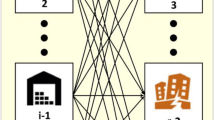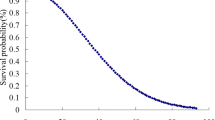Abstract
In order to solve the problems of different need of service quality and rescue level in disaster point during the process of cross-regional emergency, modeling and simulation of the covering problem of emergency rescue force layout is researched in this paper. First, complex management and social problem is transferred into mathematical problems, and mathematical model is founded by graph theory algorithm and statistics, and multi-level and multi-location model is founded from the thought of multi-service and multiple coverage. Then the model is simulated based on factual examples (matlab2012b 0-1 integer programming algorithm), and the scheme of different location layouts under different deployment strategies is obtained from the simulation results. At last, the simulation results is analyzed, and the validity of model is proved by the algorithm case, thus provides reference basis for the location selection decision under multi regional collaborative linkage model of cross regional emergency.










Similar content being viewed by others
References
Wuxiao, T., Qing, W., & Jianwei, X. (2010). Research on regionally integrated emergency response system. Journal of Social Sciences, 2010(07), 63–68.
Weiqin, T. (2008). Study on city emergency response pattern in China. Chinese Public Administration, 03, 79–82.
Xiaotao, W., & Liping, W. (2011). Empirical study on influencing factors of regional emergency response. Journal of Catastrophology, 26(3), 139–144.
Drezner, Z., & Hamacher, H. W. (2002). Facility location: Applications and theory (pp. 81–150). Berlin: Springer.
Fei, W., Xv, Y., & Yixue, L. (2006). Review on facility location models. Operations Research and Management Science, 15(5), 64–69.
Toregas, C., & ReVelle, C. (1972). Optimal location under time or distance constraints. Papers of the Regional Science Association, 28, 133–143.
Church, R., & ReVelle, C. (1974). The maximal covering location problem. Papers of the Regional Science Association, 32, 101–111.
Aly, A. A., & White, J. A. (1978). Probabilistic formation of the emergency service location problem. Journal of Operational Research Society, 29(12), 1167–1179.
ReVelle, C. S., & Eiselt, H. A. (2005). Location analysis: A synthesis and survey. European Journal of Operational Research, 165, 1–9.
Alba, E., & Dominguez, E. (2006). Comparative analysis of modern optimization tools for the p-median problem. Stat Comput, 16, 251–260.
Marvin, A. A., Jr., Sukran, N. K., & Basheer, M. K. (2006). An empirical comparison of Tabu Seacrh, Simulated Annealing, and Genetic Algorithms for facilities location problems. Int J Production Economics, 103, 742–754.
Song, H., & Chao, Y. (2009). Study on joint location-inventory model under stochastic demand. Chinese Journal of Management Science, 17(5), 96–103.
Zixue, G., Meiran, Q., & Qiang, Z. (2010). Minimum cost model of emergency material storage location based on interval number. Operations Research and Management Science, 19(1), 15–20.
Shui, W., Ye, H., & Zhang, S. (2010). Research on dynamic location model and algorithm of logistics distribution centers. Application Research of Computers, 27(12), 4476–4479.
Ko, Y. D., Song, B. D., & Hwang, H. (2016). Location, capacity and capability design of emergency medical centers with multiple emergency diseases. Computers & Industrial Engineering, 101, 10–20.
Zaffar, M. A., & Rajagopalan, H. K. (2016). Coverage, survivability or response time: A comparative study of performance statistics used in ambulance location models via simulation–optimization. Operations Research for Health Care, 11, 1–12.
Unluyurt, T., & Tuncer, Y. (2016). Estimating the performance of emergency medical service location models via discrete event simulation. Computers & Industrial Engineering, 102, 467–475.
Dong, L., Xinghua, K., Xiangtao, Y., & Donghui, P. (2013). A reliable location model for military logistics distribution centers based on multi-stages response. Operations Research and Management Science, 22(1), 147–156.
Zhizong, C., & Jianxin, Y. (2006). A multi-objective decision model of emergency rescue facility location for large-scale emergency incidents. Management Science in China, 19(4), 10–14.
Chunjing, G., Xia, W., & Xianjun, G. (2011). A multi-covering model and its algorithm for facility location response for large-scale emergencies. Operations Research and Management Science, 20(5), 50–56.
Liu, T. H., Xu, W. S., & Wu, Q. D. (2010). Modeling and algorithm for location of medical resources under large-scale emergency. Computer Engineering and Applications, 46(29), 13–17.
Wenqiang, D. (2007). Two-periods facility location optimization problem. Operations Research and Management Science, 16(6), 47–50.
Li, W. Q., & Liu, S. L. (2012). Dynamic location of single storage center with demand information updating. Operations Research and Management Science, 21(5), 61–66.
XiangLin, L., & Yunxian, H. (2010). Allocation of chinese national emergency material depository based on facility location theory. Economic Geography, 30(7), 1091–1095.
Lu, X., Hou, Y., Lin, W., & Shen, Q. (2011). Functional optimization of emergency medical service centre of small towne based on facility location theory: A case study of Tengzhou City in Shangdong Province. Economic Geography, 31(7), 1119–1123.
XiangLin, L., Yunxian, H., & Wen, L. (2011). Allocation of small-town emergency material depository based on location theory: A case study of Fangshan District in Beijing. Geographical Research, 30(6), 1000–1008.
Junhua, X., & Yunxian, H. (2013). An emergency supply stockpile location model by combining fuzzy TOPSIS method and multi-level coverage. Industrial Engineering Journal, 16(1), 91–98.
Current, J. R., & Storbeck, J. E. (1988). Capacitated covering models. Environment and Planning B: Planning and Design, 15(2), 153–163.
Pirkul, H., & Schilling, D. A. (1991). The maximal covering location problem with capacities on total workload. Management Science, 37(2), 233–248.
Junhua, X., & Yunxian, H. (2013). Empirical study on the layout optimization of regional emergency material depository: A case study of Changping District, Beijing. Economic Geography, 33(2), 135–140.
Acknowledgements
The authors acknowledge the National Natural Science Foundation of China (Grant No.: 71771061),the Science Foundation for Youths of Heilongjiang Institute of Technology (Grant No.: 2014QJ15), the Natural Science Foundation of Hei Long Jiang (Grant No.: F201422), Doctor Foundation of Heilongjiang Institute of Technology (Grant No.: 2014BJ02), the Project of Research and Development about Harbin Application Technology (Distinguished youth talents) (Grant No.: 2017RAYXJ027).
Author information
Authors and Affiliations
Corresponding author
Rights and permissions
About this article
Cite this article
Shao, M., Song, Y., Teng, C. et al. Algorithms and Simulation of Multi-Level and Multi-Coverage on Cross-Reginal Emergency Facilities. Wireless Pers Commun 102, 3663–3676 (2018). https://doi.org/10.1007/s11277-018-5399-9
Published:
Issue Date:
DOI: https://doi.org/10.1007/s11277-018-5399-9




